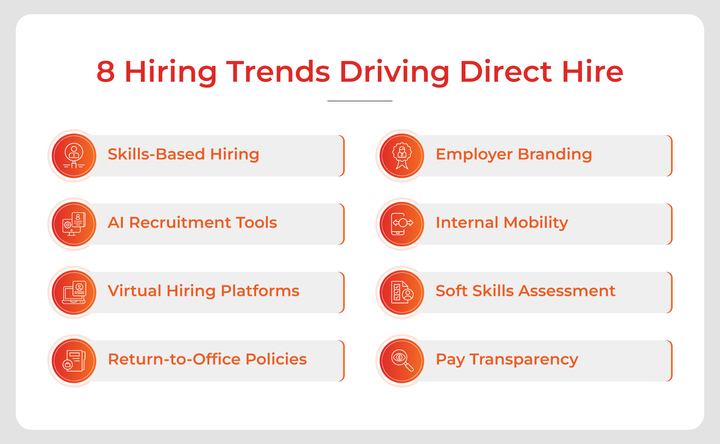Hiring has long moved from being just about headcount to long-term value. That’s exactly why direct hire staffing is taking center stage.
Amid economic uncertainty, talent reshuffling, and rising expectations from candidates, organizations are reevaluating their recruitment strategies. What’s emerging is a decisive tilt toward direct hire models that include strategies built around selecting, onboarding, and retaining full-time employees right from the start. And while the model itself isn’t new, the forces driving its resurgence in 2025 absolutely are.
Let’s explore eight powerful hiring trends that are reshaping how businesses think about workforce design and how these trends are cementing direct hire as the preferred choice in strategic talent acquisition.

1. Skills-Based Hiring Has Outpaced Traditional Credentials
Let’s face it, degrees are no longer the gold standard. Employers today are asking: Can this person do the job? Not: Where did they go to college?
That shift has put skills-based hiring at the forefront. Whether it’s AI-powered coding tests, role simulations, or portfolio-based screening, talent acquisition teams are leaning into real capability over resume fluff.
This directly benefits direct hire staffing. Why? Because when you’re making a long-term hire, you need more than a good first impression. You need proof of potential. Direct hire allows room for deeper evaluations, culture checks, and growth forecasting. When business agility depends on team performance, pedigree takes a backseat to performance.
2. Employer Branding Is a Strategic Asset
Candidates aren’t just looking for a job, but evaluating your brand. And they’re doing it long before they hit “apply.” From your DEI efforts to your Glassdoor reviews, it all counts.
That’s where employer branding becomes a competitive advantage. It influences who applies, who accepts, and who stays.
Now, connect the dots: Direct hire staffing requires trust. You’re asking someone to commit, permanently. So they need to believe in your story, your leadership, and your future. Especially for experienced or senior hires, a strong employer brand can be the tipping point between “I’ll think about it” and “Let’s do this.”
Think of it this way, contractors test your project; direct hires bet on your mission. Branding helps you win that bet.
3. AI-Powered Recruitment Is Scaling Precision, Not Just Speed
AI in hiring is about cutting noise. The best teams are using AI-powered recruitment tools not to replace intuition, but to sharpen it.
Sourcing engines now scan for intent signals. Interview bots handle early screening. Behavioral analysis tools surface alignment gaps before they become retention problems. And none of this is hypothetical. It’s happening in the ATS you already use.
So what does that mean for direct hire? Better inputs lead to better long-term hires. This way, you don’t just get candidates; you get context. AI helps your team make sharper shortlists, faster decisions, and placements that actually stick. For high-stakes roles, that precision is priceless.
Remember, AI doesn’t replace recruiters; it frees them to recruit better.
4. Internal Mobility Is Taking Center Stage
A major talent acquisition trend in 2025? Hiring from within. Internal mobility isn’t just about promotions, but about recognizing existing employees as viable candidates for open roles.
What does this mean for direct hire? It creates a dynamic where external direct hires must bring clear, additive value and not just comparable experience. This puts pressure on recruiters to vet candidates rigorously and pitch roles more strategically. The result is fewer hires, but stronger ones.
5. Virtual Hiring Platforms Are Now the Default
The entire lifecycle, from application to final offer, can now happen without stepping into an office. Virtual hiring platforms have expanded access, accelerated cycles, and made global talent acquisition more viable than ever.
This has a dual effect: it enables direct hire staffing at scale, and it increases candidate expectations. Video interviews, digital assessments, and virtual onboarding are now table stakes. Companies that lack this infrastructure struggle to land top full-time talent, regardless of their brand name or benefits.
6. Soft Skills Are Gaining Priority
Call it the “EQ revolution.” While hard skills are still measured, traits like adaptability, empathy, communication, and emotional resilience are climbing up the hiring checklist. The skill list is, thus, growing. SHRM finds that more than 75% of employers now consider soft skills as important as technical ones
In direct hire models (especially for leadership, creative, or client-facing roles), soft skills assessment is becoming mission-critical. Long-term employees influence teams, drive culture, and engage customers. Organizations aren’t just hiring performers anymore. They’re hiring connectors, listeners, and decision-makers.
7. Return-to-Office Mandates Are Redefining Role Design
The ongoing push-pull between remote and in-office work is influencing how roles are framed, filled, and funded. For many companies, roles that require physical presence are being restructured into full-time, direct hire opportunities to attract commitment.
Why? Temp or gig workers tend to prioritize flexibility. So if a role demands location-specific or team-embedded presence, direct hire staffing becomes the practical path. It’s also seen as a retention tactic, offering stability in exchange for presence.
8. Pay Transparency Laws Are Driving Employer Clarity
With legislation around salary transparency expanding rapidly across the U.S. and Europe, employers are being pushed to define and defend the value of each role. This includes publishing ranges, justifying equity, and ensuring internal alignment.
These forces reinforce the value of direct hire. When compensation is visible, candidates expect clarity, benefits, and long-term progression. Companies that offer clear salary narratives and stable employment terms are better positioned to win trust and talent.
Why Forward-Thinking Companies Are Going Direct
What ties these trends together is expectation. Candidates want meaningful work, not transactions. Employers want longevity, not churn. And recruitment teams want fewer cycles, but better outcomes.
Direct hire staffing delivers on all fronts:
- Longer retention
- Higher performance
- Stronger culture integration
- Lower long-term hiring costs
It’s no surprise that in 2025, more CHROs are baking direct hire into their core strategy, not as a backup plan, but as the default.
At SPECTRAFORCE, we offer end-to-end direct hire staffing services tailored to your business needs. Whether you’re hiring for one key role or building out entire teams, our people-first approach ensures you get talent that fits today and grows with you tomorrow.
FAQs
Direct hire means committing to full-time talent from day one, and in 2025, that’s exactly what resilience looks like. It’s not just about filling roles but building teams with staying power. With higher retention, deeper engagement, and clear career pathways, direct hire creates stability in a market that’s anything but.
Companies are valuing quality over quantity in hiring because the cost of a bad hire is just too high now. Organizations are moving away from volume-driven recruitment toward thoughtful, strategic hiring. Direct hire supports that shift and gives recruiters time to focus on alignment, not just speed. The result? Fewer hires, better outcomes, stronger teams.
Return-to-office mandates are pushing companies to rethink what they offer. And one thing’s clear: temp workers won’t anchor in-office roles. That’s why many employers are restructuring hybrid or on-site jobs into full-time, direct hire roles to secure commitment, reduce churn, and offer the kind of stability that remote-era flexibility lacks.
Temp-to-perm seems like a safe bet, but it can actually slow you down. Candidates today want clarity, not extended trial periods. While temp-to-perm works for some roles, direct hire sends a stronger message: “We’re investing in you.” And that commitment attracts better talent, especially at the mid-senior level.
Local hiring experts don’t just know the market, they own it. They understand cultural nuances, salary benchmarks, and regional talent behavior. For direct hire, that edge makes a difference. It means faster placements, stronger fits, and a smoother onboarding journey, especially when the stakes are high.



